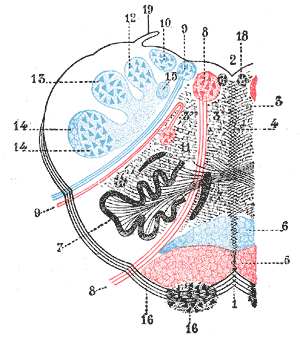Arcuate nucleus (medulla)
Arcuate Nucleus (Medulla)[edit | edit source]
The arcuate nucleus of the medulla is a small cluster of neurons located in the medulla oblongata, which is part of the brainstem. This nucleus plays a crucial role in the regulation of autonomic functions and is involved in the control of cardiovascular and respiratory systems.
Anatomy[edit | edit source]
The arcuate nucleus is situated near the pyramids of the medulla, close to the ventral surface of the brainstem. It is located anteriorly to the inferior olivary nucleus and is part of the reticular formation. The neurons in the arcuate nucleus are primarily involved in the modulation of baroreceptor reflexes and chemoreceptor reflexes, which are essential for maintaining homeostasis.
Function[edit | edit source]
The primary function of the arcuate nucleus is to integrate sensory information related to blood pressure and blood gas levels. It receives input from the carotid body and aortic body chemoreceptors, which detect changes in oxygen, carbon dioxide, and pH levels in the blood. The arcuate nucleus then processes this information and sends signals to other parts of the brainstem to adjust heart rate, blood vessel diameter, and respiratory rate.
Clinical Significance[edit | edit source]
Dysfunction of the arcuate nucleus can lead to various autonomic disorders. For instance, impaired function of this nucleus may contribute to hypertension or respiratory disorders. Understanding the role of the arcuate nucleus is important for developing treatments for these conditions.
Connections[edit | edit source]
The arcuate nucleus has extensive connections with other parts of the central nervous system. It communicates with the nucleus tractus solitarius (NTS), which is another critical center for autonomic control. The arcuate nucleus also projects to the hypothalamus, influencing endocrine and metabolic functions.
Research[edit | edit source]
Recent studies have focused on the role of the arcuate nucleus in neuroplasticity and its ability to adapt to changes in physiological conditions. Research is ongoing to explore how this nucleus can be targeted for therapeutic interventions in cardiovascular and respiratory diseases.
Related Pages[edit | edit source]
See Also[edit | edit source]
| Anatomy and morphology | ||||||||||
|---|---|---|---|---|---|---|---|---|---|---|
|
Search WikiMD
Ad.Tired of being Overweight? Try W8MD's physician weight loss program.
Semaglutide (Ozempic / Wegovy and Tirzepatide (Mounjaro / Zepbound) available.
Advertise on WikiMD
|
WikiMD's Wellness Encyclopedia |
| Let Food Be Thy Medicine Medicine Thy Food - Hippocrates |
Translate this page: - East Asian
中文,
日本,
한국어,
South Asian
हिन्दी,
தமிழ்,
తెలుగు,
Urdu,
ಕನ್ನಡ,
Southeast Asian
Indonesian,
Vietnamese,
Thai,
မြန်မာဘာသာ,
বাংলা
European
español,
Deutsch,
français,
Greek,
português do Brasil,
polski,
română,
русский,
Nederlands,
norsk,
svenska,
suomi,
Italian
Middle Eastern & African
عربى,
Turkish,
Persian,
Hebrew,
Afrikaans,
isiZulu,
Kiswahili,
Other
Bulgarian,
Hungarian,
Czech,
Swedish,
മലയാളം,
मराठी,
ਪੰਜਾਬੀ,
ગુજરાતી,
Portuguese,
Ukrainian
Medical Disclaimer: WikiMD is not a substitute for professional medical advice. The information on WikiMD is provided as an information resource only, may be incorrect, outdated or misleading, and is not to be used or relied on for any diagnostic or treatment purposes. Please consult your health care provider before making any healthcare decisions or for guidance about a specific medical condition. WikiMD expressly disclaims responsibility, and shall have no liability, for any damages, loss, injury, or liability whatsoever suffered as a result of your reliance on the information contained in this site. By visiting this site you agree to the foregoing terms and conditions, which may from time to time be changed or supplemented by WikiMD. If you do not agree to the foregoing terms and conditions, you should not enter or use this site. See full disclaimer.
Credits:Most images are courtesy of Wikimedia commons, and templates, categories Wikipedia, licensed under CC BY SA or similar.
Contributors: Prab R. Tumpati, MD





